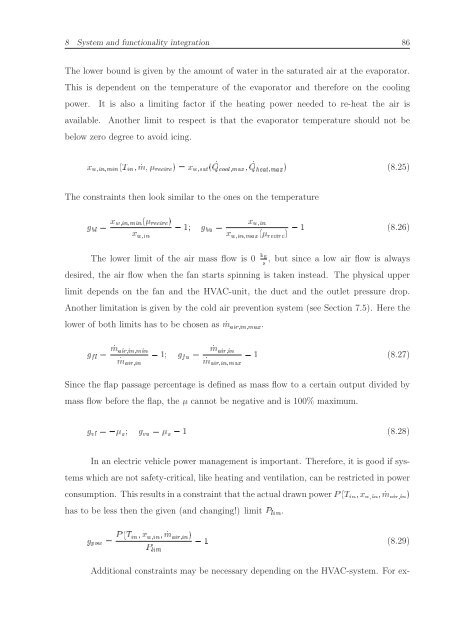Design of an Automatic Control Algorithm for Energy-Efficient ...
Design of an Automatic Control Algorithm for Energy-Efficient ...
Design of an Automatic Control Algorithm for Energy-Efficient ...
You also want an ePaper? Increase the reach of your titles
YUMPU automatically turns print PDFs into web optimized ePapers that Google loves.
8 System <strong>an</strong>d functionality integration 86<br />
The lower bound is given by the amount <strong>of</strong> water in the saturated air at the evaporator.<br />
This is dependent on the temperature <strong>of</strong> the evaporator <strong>an</strong>d there<strong>for</strong>e on the cooling<br />
power. It is also a limiting factor if the heating power needed to re-heat the air is<br />
available. Another limit to respect is that the evaporator temperature should not be<br />
below zero degree to avoid icing.<br />
�������������� ��� �������� �������� � ���������� � ���������� (8.25)<br />
The constraints then look similar to the ones on the temperature<br />
��� � ������������������<br />
�����<br />
�� ��� �<br />
�����<br />
������������������<br />
� (8.26)<br />
The lower limit <strong>of</strong> the air mass flow is 0 ��<br />
, but since a low air flow is always<br />
desired, the air flow when the f<strong>an</strong> starts spinning is taken instead. The physical upper<br />
limit depends on the f<strong>an</strong> <strong>an</strong>d the HVAC-unit, the duct <strong>an</strong>d the outlet pressure drop.<br />
Another limitation is given by the cold air prevention system (see Section 7.5). Here the<br />
lower <strong>of</strong> both limits has to be chosen as ������������.<br />
��� � ������������<br />
��������<br />
�� ��� � ��������<br />
������������<br />
�<br />
� (8.27)<br />
Since the flap passage percentage is defined as mass flow to a certain output divided by<br />
mass flow be<strong>for</strong>e the flap, the � c<strong>an</strong>not be negative <strong>an</strong>d is 100% maximum.<br />
��� � ��� ��� � �� � (8.28)<br />
In <strong>an</strong> electric vehicle power m<strong>an</strong>agement is import<strong>an</strong>t. There<strong>for</strong>e, it is good if sys-<br />
tems which are not safety-critical, like heating <strong>an</strong>d ventilation, c<strong>an</strong> be restricted in power<br />
consumption. This results in a constraint that the actual drawn power � ����������� ���������<br />
has to be less then the given (<strong>an</strong>d ch<strong>an</strong>ging!) limit ����.<br />
���� � � ����������� ���������<br />
����<br />
� (8.29)<br />
Additional constraints may be necessary depending on the HVAC-system. For ex-














